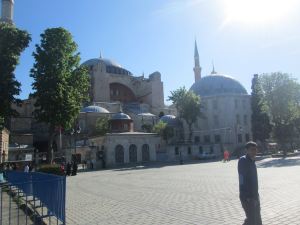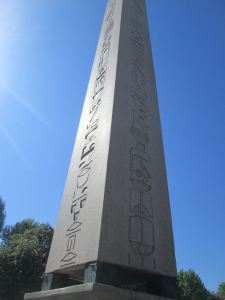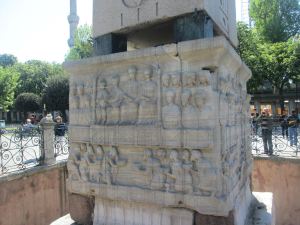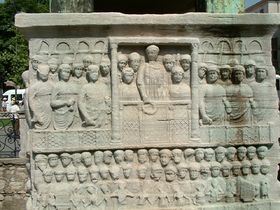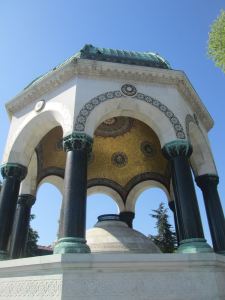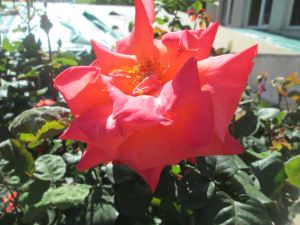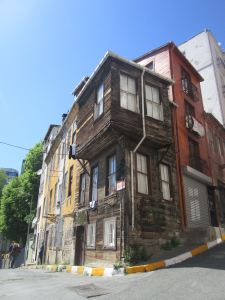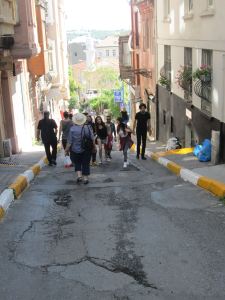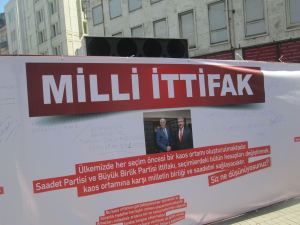See the previous post:
POST 3: Day 2 = 10th May ISTANBUL Intercontinental Hotel + General Area
___________________________________________________________________________
Note: I would like to share with you through these few words, photographs and hyperlinked websites, a 3 Dimensional experience as though you were actually there with us. Click on any photograph and it should enlarge to different size ….. at least half screen or size full screen. It will be clearer in detail than the photo on the post. It will be as if you were really there looking at the actual scene. You are an arm chair traveller with us.
If you would also like to see the post in a larger or smaller size, I suggest you follow this procedure: If you right-handed, with your left hand, press down continuously on the Control Function Key with your left hand and with your right hand, move the little cursor wheel either forwards or backwards to make the text in the post larger or smaller.
____________________________________________________________________________

We went to see the Obelisk of Theodosius from the 4th century AD.
From Wikipedia, the free encyclopedia: The Obelisk of Theodosius (Turkish: Dikilitaş) is Ancient Egyptian obelisk of Pharaoh Thutmose III re-erected in the Hippodrome of Constantinople (known today as At Meydanı or Sultanahmet Meydanı, in the modern city of Istanbul, Turkey) by the Roman emperor Theodosius I in the 4th century AD.

…. there was wedding party at the Obelisk when we were there. The little boy with the white coat and hat was part of the group ….
____________________________________________________________
From Wikipedia, the free encyclopedia
The Obelisk of Theodosius (Turkish: Dikilitaş) is the Ancient Egyptian obelisk of Pharaoh Thutmose III re-erected in the Hippodrome of Constantinople (known today as At Meydanı or Sultanahmet Meydanı, in the modern city of Istanbul, Turkey) by the Roman emperor Theodosius I in the 4th century AD.
History
The obelisk was first set up by Thutmose III (1479–1425 BC) to the south of the seventh pylon of the great temple of Karnak. The Roman emperor Constantius II (337-361 AD) had it and another obelisk transported along the river Nile to Alexandria to commemorate his ventennalia or 20 years on the throne in 357. The other obelisk was erected on the spina of the Circus Maximus in Rome in the autumn of that year, and is today known as the Lateran obelisk, whilst the obelisk that would become the obelisk of Theodosius remained in Alexandria until 390, when Theodosius I (378-392 AD) had it transported to Constantinople and put up on the spina of the Hippodrome there.
Description Obelisk:
The Obelisk of Theodosius is of red granite from Aswan and was originally 30m tall, like the Lateran Obelisk. The lower part was damaged in antiquity, probably during its transport or re-erection, and so the obelisk is today only 18.54m (or 19.6m) high, or 25.6m if the base is included. Between the four corners of the obelisk and the pedestal are four bronze cubes, used in its transportation and re-erection.[2]
Each of its four faces has a single central column of inscription, celebrating Thutmose III’s victory on the banks of the river Euphrates in 1450 BC.[1]
Bottom of the inscription (south face).
Top of the inscription (south face).
Pedestal
Detail of the pedestal: Theodosius I offers laurels of victory; we can see the water organ of Ctesibius, in the lower right-hand corner.
The marble pedestal had bas-reliefs dating to the time of the obelisk’s re-erection in Constantinople. On one face Theodosius I is shown offering the crown of victory to the winner in the chariot races, framed between arches and Corinthian columns, with happy spectators, musicians and dancers assisting in the ceremony. In the bottom right of this scene is the water organ of Ctesibius and on the left another instrument.
The emperor and his court (south face).
The chariot race (south face).
Submission of the barbarians (west face).
There are obvious traces of major damage to the pedestal and energetic restoration of it. Missing pieces have been replaced, at the pedestal’s bottom corners, by cubes of porphyry resting on the bronze cubes already mentioned – the bronze and porphyry cubes are of identical form and dimensions. There is also a vertical gash up one of the obelisk’s faces, which looks like a canal from above. These repairs to the base may be linked to the cracking of the obelisk itself after its suffering a serious accident (perhaps an earthquake) at an unknown date in antiquity.[2]
The emperor and his court – bronze and porphyry cubes ; gash (north face).
Transport of the obelisk.
Traces of a vertical gash (north face).
Inscriptions

Latin inscription (east face)
The pedestal’s east face bears an inscription in five Latin hexameters. This is slightly broken at the bottom but it was transcribed in full by travellers in the 16th century. It reads:
- DIFFICILIS QVONDAM DOMINIS PARERE SERENIS
- IVSSVS ET EXTINCTIS PALMAM PORTARE TYRANNIS
- OMNIA THEODOSIO CEDVNT SVBOLIQVE PERENNI
- TER DENIS SIC VICTVS EGO DOMITVSQVE DIEBVS
- IVDICE SVB PROCLO SVPERAS ELATVS AD AVRAS
Translation:
- “Though formerly I opposed resistance, I was ordered to obey the serene masters and to carry their palm, once the tyrants had been overcome. All things yield to Theodosius and to his everlasting descendants. This is true of me too – I was mastered and overcome in three times ten days and raised towards the upper air, under governor Proculus.”

Greek inscription (west face).
On the west face the same idea is repeated in two elegiac couplets rendered in Byzantine Greek, though this time it reports that the re-erection took 32 days (TPIAKONTA ΔYO, last line) not 30:[2]
- KIONA TETPAΠΛEYPON AEI XΘONI KEIMENON AXΘOC
- MOYNOC ANACTHCAI ΘEYΔOCIOC BACIΛEYC
- TOΛMHCAC ΠPOKΛOC EΠEKEKΛETO KAI TOCOC ECTH
- KIΩN HEΛIOIC EN TPIAKONTA ΔYO
Translation:
- “This column with four sides which lay on the earth, only the emperor Theodosius dared to lift again its burden; Proclos was invited to execute his order; and this great column stood up in 32 days.”
Notes
- Labib Habachi, The Obelisks of Egypt, skyscrapers of the past, American University in Cairo Press, 1985, p.145-151.
- E.A. Wallis Budge, Cleopatra’s Needles and Other Egyptian Obelisks, The Religious Tract Society, London, 1926, reprinted 1990, p.160-165.
Bibliography
- Labib Habachi, The Obelisks of Egypt, skyscrapers of the past, American University in Cairo Press, 1985, ISBN 977-424-022-7
- “Obelisk of Theodosius”, in volume 3 of Alexander Kazhdan (ed.), The Oxford Dictionary of Byzantium, 3 volumes, Oxford University Press, 1991, ISBN 0-19-504652-8
- (French) Jean-Pierre Sodini, “Images sculptées et propagande impériale du IVe au VIe siècles : recherches récentes sur les colonnes honorifiques et les reliefs politiques à Byzance”, Byzance et les images, La Documentation Française, Paris, 1994, ISBN 2-11-003198-0, pp. 43–94.
- E. A. Wallis Budge, Cleopatra’s Needles and Other Egyptian Obelisks, The Religious Tract Society, London, 1926 (ISBN 0-486-26347-9)
- Linda Safran, “Points of View: The Theodosian Obelisk Base in Context.” Greek, Roman, and Byzantine Studies 34, no. 4 (Winter 1993), pp. 409–435.
______________________________________________________________________
A Note on the Photos Below: If you click on a photo, it should come up to full screen. If it doesn’t come up to full screen, follow the note above on making text larger or smaller:
If you would also like to see the post in a larger or smaller size, I suggest you follow this procedure: If you right-handed, with your left hand, press down continuously on the Control Function Key with your left hand and with your right hand, move the little cursor wheel either forwards or backwards to make the text in the post larger or smaller. Click on the reverse arrow at the top of your screen and you will come back to the normal website photos.
______________________________________________
Harriet and I and the 350 of us had the whole afternoon off from the scheduled Voyages to Antiquity activities. We personally went exploring Istanbul around our hotel and get some lunch in the process. We did have a map! It is fascinating to see how other cultures layout their cities, build houses and units, grow gardens and organise their lives. History is the laid over this. It is a strange experience in having a sense of time and purpose for going out and having curiosity to explore how another culture does things. These are some things we saw:
…. Roses in bloom in a garden we were passing …..
…. A block of units to live in …..
… an unpainted timber house on a corner …
…. A Turkish Bath House that has been in existence since 1445 …
….. Unusual hanging glass lights in a house we were passing …. a metal door to the house …
….. A side street we were passing down to get to a road that would eventually lead back to our hotel …
…. boxes of herbs make an interesting entry to a house ……
… a stone built house with a small metal – railed veranda …
…. a whimsical side street with hand- cut cobblestones on the street surface …. very old ….
…. a big stone wall with ivy growing over it it ….this gives a very big green living curtain feel …
…. A political procession was being organised when we came through this area ….
… This was a big political sign aligned on street with the political procession in Istanbul ……
…. Frequently there would little side streets like this one above for going to get a meal or have a coffee ….. there is a far more communal feel to the Istanbul culture than the Australian one Harriet and I are used to.
___________________________________________________________________
Going to Find Some Lunch ….. we went down this steep side street with a red theme and many little meal eating terraces and found a lovely place to have lunch. Do they understand English? ….. they did!! We ordered some nice Turkish Kebabs which we could make ourselves from the Turkish bread and supplied ingredients …. It was different to the way we eat meals in Australia …
…. It was lovely location to enjoy lunch and the food was beautiful ….

…. Ken standing for the photograph in the street … the lunch was so interactive, it felt as though we were at home in Australia ….
…… because the street was so narrow, I wanted to take some well positioned photos from a terrace down the street. I had moved close to this couple to look up the street. I apologised for intruding their space. They were so helpful and responsive … they were tourists also visiting Istanbul. They let me take their photograph …..
_____________________________________________________________________________
See the next post:

